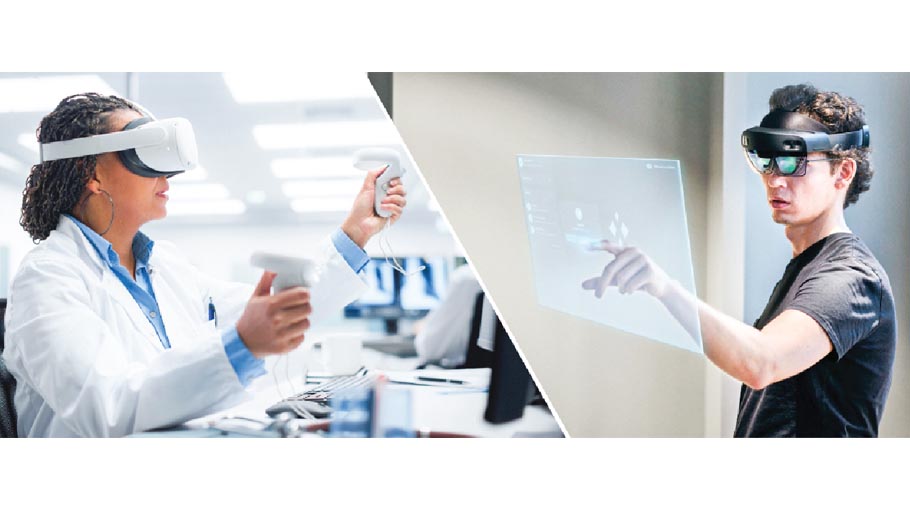Virtual Reality and Augmented Reality

Virtual Reality (VR) is a computer-generated simulation of a three-dimensional environment that can be interacted with in a seemingly real or physical way. It is typically experienced through the use of a VR headset, which tracks the user's movements and adjusts the display accordingly to create an immersive experience.
Augmented Reality (AR) is a technology that overlays digital information onto the real world. It is typically experienced through the use of a smartphone or tablet camera, which captures the user's surroundings and adds digital elements to it in real-time.
Differences between VR and AR
The main difference between VR and AR is that VR creates a completely artificial environment, while AR enhances the real world with digital elements. VR is typically used for immersive experiences, such as gaming or virtual field trips, while AR is used for more practical applications, such as learning or navigation.
Types of VR and AR
The main formats for VR and AR include:
• Immersive Virtual Reality: This is a fully interactive 3D environment that the user can interact with.
• Non-Immersive Virtual Reality: This typically involves a computer screen or projection.
• Augmented Virtual Reality: This type of AR involves the use of a headset or glasses to overlay digital elements onto the real world.
• Marker-Based AR: Scanning markers or codes triggers digital elements in the real world.
• Marker-less AR: Computer vision technology recognizes and responds to objects in the real world.
Current State of VR and AR
VR and AR technology have come a long way in recent years, with advancements in hardware and software making it more accessible and affordable. VR headsets have become increasingly popular, while AR technology is now integrated into many smartphones and tablets.
VR and AR have a wide range of applications in education:
• Immersive learning: VR and AR can be used to create immersive learning experiences, such as virtual field trips or simulations. This allows for students to connect closer with their education and potentially reach new limits of learning that the traditional classroom cannot stimulate.
• Personalized Learning: AI-powered educational platforms and tools can adapt to individual student needs. They analyze data on student performance and learning styles to create personalized learning pathways. This helps students learn at their own pace and provides targeted support and resources to address their specific strengths and weaknesses.
• Intelligent Tutoring Systems: AI-driven tutoring systems provide real-time feedback and assistance to students. These systems can answer questions, explain concepts, and offer practice problems. Since they’re available 24/7, learning is more accessible and immediate support is there when students need it.
• Data Analytics for Educators: AI enables educators and administrators to make data-driven decisions. They can analyze large datasets to identify trends, track student progress, and assess the effectiveness of teaching methods and curriculum. AI-driven insights help schools and institutions refine their strategies to improve educational outcomes.
• Automating Administrative Tasks: AI can streamline administrative tasks for educators, allowing them to focus more on teaching. Chatbots and virtual assistants can handle routine inquiries from students, parents, and staff, freeing up educators' time. AI can also assist in grading assignments and assessments, reducing the administrative burden.
The challenges and opportunities in the field of VR and AR include:
Privacy and Security: As VR and AR technology becomes more widespread, there may be concerns about privacy and security. This can involve security breaches in data and personal information being leaked online. It is important to implement proper online security barriers and security measures to avoid issues.
Education and Training: VR and AR can be used to create immersive learning experiences, but there may be challenges in integrating them into traditional education and training methods. More research and implementation would lead to a better incorporation of this technology with modern education.
Accessibility: While VR and AR technology is becoming more accessible, there is still a long way to go in terms of making it available to everyone. There are still barriers for some individuals who have disabilities preventing them from fully enjoying this technology, but with proper time and advancement, there can be improvements.
Impact on education and training: VR and AR have the potential to revolutionize education and training by creating immersive and interactive learning experiences. Virtual field trips, simulations, and training exercises can all be created using VR and AR technology, providing a more engaging and effective way of learning. Immersive learning experiences using AR technology can also benefit learners and allow for a closer connection between student and subject, in turn, creating a hands-on approach to every lesson.
VR and AR are two of the most exciting and rapidly evolving technologies of our time. They have the potential to revolutionize various industries, from education and training to entertainment and healthcare. While there are challenges and opportunities in the field, the potential for growth and development is enormous. Further exploration and adoption of VR and AR technology helps to unlock its full potential and provide more opportunities for better learning.




